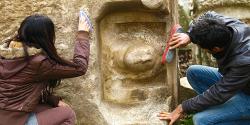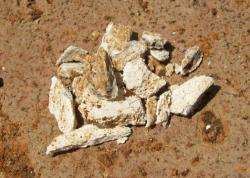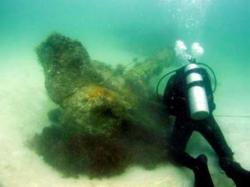02 JANVIER
INDI-UNI : ANTHROPOLOGY - ARCHAEOLOGY
INSCRIPTION 2012 COURS A DISTANCE
REGISTRATION 2012 ONLINE COURSES
TURQUIE –  Stratonikeia - A 2,000-year-old relief bust of a king was discovered during excavations in ancient Stratonikeia in Muğla's Yatağan district. Dr. Bilal Söğüt, a professor of archeology at Pamukkale University and head of the excavations, told the Anatolia news agency that they found a street in the ancient city which began with a gate and was lined with columns. During their excavations, they also discovered the bust of a king dating back to the Hellenistic period. The bust, which is one-and-a-half meters tall and nearly two meters wide, features depictions of bull heads and the figure of a goddess, Söğüt said. “The depictions of bull heads on the bust represent wealth and power. It was in this region that we previously found a racing chariot. The discovery of 1,500-year-old mosaics here was another welcome breakthrough for us,” he said. According to Söğüt, the city walls constitute an important part of the excavation work carried out in the ancient city. “The city walls were restored approximately 2,400 years ago by King Mausolus. We have begun excavating these 2,400-year-old walls of this ancient city. Upon the completion of the excavations, we will start work on restoring the area,” he said. Söğüt said he thinks the walls surrounding the ancient city are nearly 3,600 meters long. “We discovered that one 400-meter section of wall has been preserved to this day. After completing restoration, we will open the wall to visitors," Söğüt said. A 100-person team of academics, field workers and students discovered 460 artifacts in the ancient city in the seven-month-long excavations that took place last year, according to Söğüt. The artifacts were delivered to the Muğla Museum. The pieces date back to the Roman and Byzantine periods, he said.
Stratonikeia - A 2,000-year-old relief bust of a king was discovered during excavations in ancient Stratonikeia in Muğla's Yatağan district. Dr. Bilal Söğüt, a professor of archeology at Pamukkale University and head of the excavations, told the Anatolia news agency that they found a street in the ancient city which began with a gate and was lined with columns. During their excavations, they also discovered the bust of a king dating back to the Hellenistic period. The bust, which is one-and-a-half meters tall and nearly two meters wide, features depictions of bull heads and the figure of a goddess, Söğüt said. “The depictions of bull heads on the bust represent wealth and power. It was in this region that we previously found a racing chariot. The discovery of 1,500-year-old mosaics here was another welcome breakthrough for us,” he said. According to Söğüt, the city walls constitute an important part of the excavation work carried out in the ancient city. “The city walls were restored approximately 2,400 years ago by King Mausolus. We have begun excavating these 2,400-year-old walls of this ancient city. Upon the completion of the excavations, we will start work on restoring the area,” he said. Söğüt said he thinks the walls surrounding the ancient city are nearly 3,600 meters long. “We discovered that one 400-meter section of wall has been preserved to this day. After completing restoration, we will open the wall to visitors," Söğüt said. A 100-person team of academics, field workers and students discovered 460 artifacts in the ancient city in the seven-month-long excavations that took place last year, according to Söğüt. The artifacts were delivered to the Muğla Museum. The pieces date back to the Roman and Byzantine periods, he said.
http://www.todayszaman.com/news-267387-2000-year-old-relief-bust-found-in-stratonikeia.html
INDE –  Idukki - The nannangady (burial urn) believed to be of megalithic era recently excavated from a construction site near Ramakkalmedu in Idukki district throw light on the possibility of carbon dating for further studies as there were bone remains found inside it. The site was located at Thovalappady en route to Ramakkalmedu from Thookkupalam on the side of the Thoovalappady - Manchanmettu road and it is one of the many sites of megalithic remains excavated in the district. T. Rajesh, historian, who led the excavation said that it was for the first time that the chances of in-depth technical study could be made possible as the bone remains could provide data on the period of the burial urn and it shows that a society which revered the dead and a prominent civilisation existed in the eastern hills of the district. The Nanangadi is about one metre height and its brim had a diameter of about 12 inches. The top of the urn was covered with a round shaped stone slab. Two small pots looked like coconut and a bowl having a diameter of about eight inches were placed near the urn. A human bone was found in the ‘nannangadi.' “The red and black pottery is remarkable as it denotes the Dravidian expansion to South India, '' Mr Rajesh said. It was for the first time that a human bone was fond in a nannangadi and this biological element is very important because it will open the window for scientific studies, he said. Megalithic evidences like dolmens (muniyaras), table stones, burial urns and historic stones believed to be of BC 1050 and AD 300 was discovered at various locations in the eastern parts of the district.
Idukki - The nannangady (burial urn) believed to be of megalithic era recently excavated from a construction site near Ramakkalmedu in Idukki district throw light on the possibility of carbon dating for further studies as there were bone remains found inside it. The site was located at Thovalappady en route to Ramakkalmedu from Thookkupalam on the side of the Thoovalappady - Manchanmettu road and it is one of the many sites of megalithic remains excavated in the district. T. Rajesh, historian, who led the excavation said that it was for the first time that the chances of in-depth technical study could be made possible as the bone remains could provide data on the period of the burial urn and it shows that a society which revered the dead and a prominent civilisation existed in the eastern hills of the district. The Nanangadi is about one metre height and its brim had a diameter of about 12 inches. The top of the urn was covered with a round shaped stone slab. Two small pots looked like coconut and a bowl having a diameter of about eight inches were placed near the urn. A human bone was found in the ‘nannangadi.' “The red and black pottery is remarkable as it denotes the Dravidian expansion to South India, '' Mr Rajesh said. It was for the first time that a human bone was fond in a nannangadi and this biological element is very important because it will open the window for scientific studies, he said. Megalithic evidences like dolmens (muniyaras), table stones, burial urns and historic stones believed to be of BC 1050 and AD 300 was discovered at various locations in the eastern parts of the district.
http://www.thehindu.com/news/states/kerala/article2760861.ece
ROYAUME UNI - Ness of Brodgar - Archeologists have so far found undisturbed artefacts including wall decorations, pigments and paint pots, which are already increasing their understanding of the Neolithic people. Experts believe the huge outer wall suggests the site was not domestic, while the layout of the buildings has reinforced the view it might have been a major religious site. Archaeologists think the temple was built 500 years before Stonehenge, regarded as the centre of Stone Age Britain. However, only 10% of the site at Ness of Brodgar has been excavated and it could be years before the scale and age of the discovery is fully understood. It sits close to the existing Ring of Brodgar stone circles and the standing stones of Stenness, near to the town of Stromness. The uncovered wall around the edges of the site was built with 10,000 tonnes of quarried rock and may have been up to 10 ft high. Thermal technology also indicates the site could cover the same area as five football pitches, with some parts potentially older than Stonehenge, in south-west England, by as much as 800 years. Charcoal samples from beneath the wall indicate it was built around 3200 BC. A 30mm high figurine with a head, body and two eyes, and called the "Brodgar Boy", was also unearthed in the rubble of one of the structures. About 18 months ago, a remarkable rock coloured red, orange and yellow was unearthed. This is the first discovery in Britain of evidence that Neolithic peoples used paint to decorate their buildings.
http://www.heraldscotland.com/news/home-news/orcadian-temple-predates-stonehenge-by-500-years.16330802
ESPAGNE –  Valderados - A priceless IV Century Roman mosaic in Baños de Valderados, Burgos, has been irreparably damaged by thieves, who ripped out three separate sections, including one measuring almost 2.5 square metres. The 66 square metre mosaic was only discovered in 1972 and depicts the Roman god Bacchus and was one of the best preserved Roman mosaics of the Iberian Peninsula.
Valderados - A priceless IV Century Roman mosaic in Baños de Valderados, Burgos, has been irreparably damaged by thieves, who ripped out three separate sections, including one measuring almost 2.5 square metres. The 66 square metre mosaic was only discovered in 1972 and depicts the Roman god Bacchus and was one of the best preserved Roman mosaics of the Iberian Peninsula.
http://www.typicallyspanish.com/news/publish/article_33201.shtml
USA – Tampa Bay - A Civil War-era ship that participated in one of the nation's most famous naval battles before sinking in the mouth of Tampa Bay is set to become Florida's 12th underwater archaeological preserve. The wreck of the USS Narcissus tugboat off Egmont Key just north of Anna Maria Island provides not only a fascinating underwater preserve to explore. Built in East Albany, N.Y., in 1863, the Narcissus steamed south in January 1864 to support the Union Navy's blockade of Confederate shipping routes, according to a report complied by state researchers. The ship was involved in operations from New Orleans to Pensacola, but its most famous engagement came during the Battle of Mobile Bay on Aug. 5, 1864. The union fleet's victory at Mobile Bay captured a key Confederate port and lived on in popular culture thanks to the "Damn the torpedoes!" command attributed to Rear Adm. David G. Farragut as he urged his ships forward against an array of defenses. The Narcissus was ordered to return north for sale after the war but sank in 1866 off Egmont during the journey, killing the entire crew. Once almost completely buried in sand, the shipwreck reemerged in recent years about 15 feet below the surface, according to the state report. A 2006 archaeological expedition reported "all of the steam machinery, propeller, propeller shaft, pillow block, boiler pieces, and a portion of the wooden hull were exposed."
Tampa Bay - A Civil War-era ship that participated in one of the nation's most famous naval battles before sinking in the mouth of Tampa Bay is set to become Florida's 12th underwater archaeological preserve. The wreck of the USS Narcissus tugboat off Egmont Key just north of Anna Maria Island provides not only a fascinating underwater preserve to explore. Built in East Albany, N.Y., in 1863, the Narcissus steamed south in January 1864 to support the Union Navy's blockade of Confederate shipping routes, according to a report complied by state researchers. The ship was involved in operations from New Orleans to Pensacola, but its most famous engagement came during the Battle of Mobile Bay on Aug. 5, 1864. The union fleet's victory at Mobile Bay captured a key Confederate port and lived on in popular culture thanks to the "Damn the torpedoes!" command attributed to Rear Adm. David G. Farragut as he urged his ships forward against an array of defenses. The Narcissus was ordered to return north for sale after the war but sank in 1866 off Egmont during the journey, killing the entire crew. Once almost completely buried in sand, the shipwreck reemerged in recent years about 15 feet below the surface, according to the state report. A 2006 archaeological expedition reported "all of the steam machinery, propeller, propeller shaft, pillow block, boiler pieces, and a portion of the wooden hull were exposed."
http://www.heraldtribune.com/article/20111229/ARTICLE/111229505
FRANCE – Chassenon - Les archéologues sont à la recherche du pont romain qui franchissait la Vienne à Chassenon. Des fouilles subaquatiques sont programmées au printemps. Question: les Romains avaient-ils construit un pont pour franchir la Vienne tout près du site de Cassinomagus, là où les deux communes de Chassenon et d'Etagnac comptent chacune un hameau qui s'appelle «Pilas»? Bien possible. Ou probable. Une première phase de diagnostic de cette opération pilotée par le département de la Charente s'est déroulée au mois de juin dernier. «Tout est parti du projet d'une entreprise, la SARL Hydro-Tres, qui veut réaliser une centrale hydroélectrique sur le site d'un ancien moulin du XIIIe siècle, auquel a succédé au XIXe siècle une première usine hydroélectrique», décrit Sandra Sicart. Or cette ancienne centrale électrique, aujourd'hui rasée, pourrait bien se trouver sur l'axe routier qui menait de Vesunna - Périgueux - à Lemonum - Poitiers - à l'époque romaine. Voie nord-sud qui coupait à Cassinomagus/Chassenon, le grand axe transversal de la Gaule de César et d'Auguste, la via Agrippa qui reliait Mediolanum Santonum - Saintes - à Lugdunum, Lyon. Et pour franchir une rivière, rien de tel qu'un pont. «La toponymie locale pourrait nous donner raison avec ce "Pilas" qui rappelle les piles d'un pont et qu'on retrouve de chaque côté de la Vienne», note l'archéologue, toutefois déçue de ne pas avoir retrouvé au mois de juin les bases de ce pont. Encore que... «On a retrouvé un ancien mur, probablement l'un des murs du moulin du XIIIe siècle, dans lequel étaient inclus de très gros blocs de granit, peut-être les fondations du pont antique que nous recherchons», explique-t-elle. Ce pont qu'en 1936, le propriétaire d'alors de l'usine hydroélectrique avait peut-être trouvé en asséchant pour partie la rivière, découvrant dans le lit des blocs carrés accrochés les uns aux autres par des crampons en fer, ainsi qu'un bec triangulaire en pierre, cet élément qui protège traditionnellement les ponts côté amont. Pour faire la lumière sur ce site, deux phases d'investigation sont programmées en avril-mai (cinq jours) et juin-juillet (cinq jours). Avec des fouilles subaquatiques qui pourraient permettre de retrouver les fondations de ce fameux pont, situé à 3 kilomètres au nord des thermes de Chassenon.
http://www.charentelibre.fr/2011/12/30/il-suffit-de-trouver-le-pont,1072329.php